Sainte-Geneviève Library


Sainte-Geneviève Library (French: Bibliothèque Sainte-Geneviève) is a public and university library in Paris, which inherited the collection of the Abbey of St Genevieve. The library contains around 2 million documents.[1]
History
The Sainte-Geneviève Library inherited the writings and collections of one of the largest and oldest abbeys in Paris. Founded in the sixth century by Clovis I and subject to the rule of St Benedict, the abbey was initially dedicated to the apostles Peter and Paul. In 512 the body of St Genevieve, later the patron saint of Paris was buried there and in time became the new dedication. The monastery was repeatedly plundered by the Normans in the ninth and tenth centuries, yet increased activity is visible in the early eleventh century. Subsequent decadence led to a reform in 1148 promoted by the abbot of Saint-Denis, Suger, then regent of France. The Canons Regular of St Augustine were installed at the abbey until the Revolution, maintaining the library and a school of copyists. The oldest known manuscript from the library of the abbey, now preserved at the Public Library of Soissons (ms 80) is an ex-libris of the twelfth century: Iste liber is Sancte Genovefa parisiensis. As was the custom in ecclesiastical libraries, this mark of ownership is accompanied by a threatened penalty for anyone daring to steal the book or simply mask the ex-libris: Quicumque furatus eum fuerit, vel celaverit, vel ab ecclesia subduxerit, vel titulum istum deleverit, anathema sit (Whoever steals this, or uses the offices of the church to withdraw it, or removes or otherwise conceals its title, he is anathema).[2]
A copy of the library catalogue, executed in the thirteenth century (Bibliothèque nationale de France, MS lat. 16,203, fol. 71V) reports of 226 volumes, of which only 3 or 4 can now be identified with certainty in the collections of Library Sainte-Genevieve. Besides the manuscripts inventoried - collections of sermons, canon law, the works of the fathers of the church, the glosses and commentaries on the Scriptures of Rabanus Maurus and the Venerable Bede—the abbey had certainly other books, bibles, missals or gradual, earmarked specifically for worship. But during the sixteenth century, weakening of community and misrule were due to dispersion of the volumes of the library. Many manuscripts, the library of the abbey tried to recover the next century, were then sold, sometimes at the price of paper. Reform resulted in the true foundation of the Royal Library Sainte-Genevieve.[2]
Architecture
Between 1838 and 1850, the current Sainte-Geneviève Library was designed and constructed under the direction of the architect Henri Labrouste. The glass and iron reading room has been described as "magisterial", making the building a seminal work in the creation of the modern library as "a temple of knowledge and space for contemplation".[3] The names of 810 illustrious scholars are inscribed on the library facade.[4]
"One of the greatest cultural buildings of the nineteenth century to use iron in a prominent, visible way was unquestionably the Bibliothèque Ste.-Genevieve in Paris, designed by Henri Labrouste. He presented the design on December 19, 1839. It took six to seven years to complete the construction, from 1843–50. The large (278 by 69 feet) two-storied structure filling a wide, shallow site is deceptively simple in scheme: the lower floor is occupied by stacks to the left, rare-book storage and office space to the right, with a central vestibule and stairway leading to the reading room which fills the entire upper story. The ferrous structure of this reading room—a spine of slender, cast-iron Ionic columns dividing the space into twin aisles and supporting openwork iron arches that carry barrel vaults of plaster reinforced by iron mesh—has always been revered by Modernists for its introduction of high technology into a monumental building."
— Marvin Trachtenberg and Isabelle Hyman. Architecture: from Prehistory to Post-Modernism. p478.
The Bibliothèque Ste.-Genevieve structure designed by Labrouste stands at the Sainte-Genevieve hill, across the street from the Pantheon, in the Latin Quarter. The close proximity of the Pantheon may have been the cause for Labrouste to add a leafy garland band above the windows on the first level exterior nearly identical to the band on the Pantheon, perhaps as Labrouste's notion of respect to the monument of Roman Architecture.
Directors and principal keepers
- Charles Kohler ( ? - 1917)
- Charles Mortet (1917–1922)
- Paul Roux-Fouillet (1977–1987)
- Geneviève Boisard (1987–1997)
- Nathalie Jullian (1997–2006)
- Yves Peyré (2006 - )
Notable readers
Architectural drawings
-

Ground floor plan (hall)
-

Main floor plan (reading room)
-

Hall and reading room elevation)
-

Façade
References
- ↑ Sainte-Geneviève Library, retrieved 1 April 2013
- ↑ 2.0 2.1 Sainte-Geneviève Library: History, retrieved 1 April 2013
- ↑ "Henri Labrouste: Structure Brought to Light". moma.org. March 10, 2013. Retrieved March 23, 2013.
- ↑ Henri Labrouste et la bibliothèque Sainte-Geneviève, Annie Le Saux, BBF 2002 - Paris, t. 47, n° 2
Further reading
- "New Library". Gleason's Pictorial (Boston, Mass.) 2. 1852.
External links
| Wikimedia Commons has media related to Bibliothèque Sainte-Geneviève. |
Coordinates: 48°50′49.5″N 2°20′45″E / 48.847083°N 2.34583°E